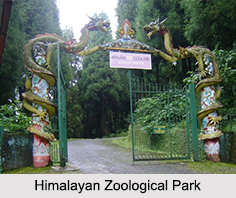 Himalayan Zoological Park is the first Zoological park of Sikkim. The park accomplishes the perception of modern zoo, where the animals are kept in replicated natural conditions. It is a kind of an open air zoo. To facilitate the visitors with the view of some unique sites of the park, the Government has made provisions for rope way. While the park fulfils all the basic requirements of a zoological park, it also provides full freedom of movement for the animals. Himalayan Zoological Park has been well maintained by the Government of Sikkim under Department of Forest, Environment and Wildlife.
Himalayan Zoological Park is the first Zoological park of Sikkim. The park accomplishes the perception of modern zoo, where the animals are kept in replicated natural conditions. It is a kind of an open air zoo. To facilitate the visitors with the view of some unique sites of the park, the Government has made provisions for rope way. While the park fulfils all the basic requirements of a zoological park, it also provides full freedom of movement for the animals. Himalayan Zoological Park has been well maintained by the Government of Sikkim under Department of Forest, Environment and Wildlife.
History of Himalayan Zoological Park
Built in 1991, it was the first environmental park which was developed in North Eastern part of India. This park was mainly established to preserve the rare species of wild animals without disturbing their natural habitat.
Geography of Himalayan Zoological Park
Himalayan Zoological Park is located at a distance of 3 kms from Gangtok. Located at an altitude of 5,840ft (1,780 mts) in Bulbuley, Himalayan Zoological Park shares a splendid view of Mt. Kanchenjunga. The park stretches up to an area of 205 hectares in the mountainous terrain.
Flora of Himalayan Zoological Park
Along with various types of fauna, the place is also known for the unique floral collection which includes thick bushes, shrubs which are mainly found in the Himalayan region.
Fauna of Himalayan Zoological Park
Himalayan Zoological Park has a variety of rare and endangered species of animals. Animals available in the Zoo includes Red Pandas, Himalayan Black Bears, Snow Leopards, Clouded Leopard, Common Leopard, Leopard Cat, Tibetan Wolf, Himalayan Palm Civets, Large Indian Civets, Gorals, Barking Deer, Yaks, Porcupine, etc. One can also see different types of birds here like Golden Pheasant, Silver Pheasant, Lady Amherst Pheasant, Kalij, Satyr Tragopan, etc.
Visiting Information of Himalayan Zoological Park
A nominal admission fee is required to enter the park. The Zoo is open from 9am to 4pm daily (except Thursday). The Bagdogra Airport is the nearest airport to the location. The nearest railway station at Darjeeling is the best stop to reach the park conveniently. One can avail buses or taxis from here to reach the park. The best time to visit the area is during mid- February to May and Mid-September to December.



















